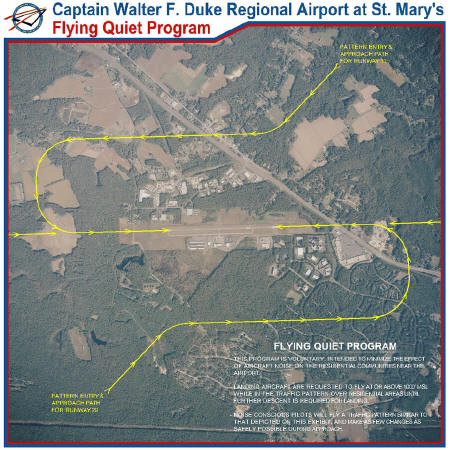Flying Quiet Program

In 2003, the St. Mary’s County Regional Airport instituted a voluntary "Fly Quiet" aircraft noise reduction program to minimize the effect of aircraft noise on neighboring residential communities. The voluntary program is not a result of any specific noise problems. It is a commitment to the local community by the County that the Airport is a responsible neighbor promoting airport noise reduction to every extent possible, within the constraints of safety and promoting commerce. The plan was developed by the DPW&T Airport Manager and Airport Advisory Committee with input from local homeowners, pilots, and Airport businesses. This Program was discussed by the Commissioners of St. Mary's County prior to their adoption of the Airport Master Plan on September 3, 2002. The Maryland Aviation Administration Annual operations at the airport are estimated by acoustical traffic counters to between 41,828 and 31,934.
The "Fly Quiet" Program requests that pilots reduce power or propeller RPM as soon after take-off as is safely possible. Propellers generate more noise than engines, thus flying with the lowest practical RPM setting will reduce aircraft noise substantially. Pilots flying VFR (Visual Flight Rules) departures who participate in the program will gain altitude as quickly as possible without compromising safety and fly a departure track which minimizes residential over-flights until the aircraft reaches an altitude of 1,500 feet MSL.
Landing aircraft are requested to fly at or above 1,000 feet MSL while in the traffic pattern over residential areas until a further descent is required for landing. Pilots should avoid sudden RPM or power changes when over residential areas. Use of the Precision Approach Path Indicator (PAPI) will indicate a safe glide path and a low smooth, quiet descent to the runway. Noise conscious pilots will fly a tight landing pattern, keeping the aircraft noise as close to the airport as possible. If possible, wait until short final to adjust the propeller control to flat pitch and make as few power changes as possible during approach.
For concerns about aircraft noise, please contact the Patuxent River NAS Noise Hotline at 866-819-9028.
Access the FAA web site if you would like to search "N" numbers to find the owner(s) of a particular aircraft(s).
Aerobatic Flight
In accordance with Chapter 14 Code of Federal Regulations Part. 91.303(c), as long as the operational requirements of the airspace and other aerobatic flight requirements can be met, pilots may perform aerobatics under the outer areas of Class B and Class C airspace. Aerobatic flight means an intentional maneuver involving an abrupt change in an aircraft’s attitude, an abnormal attitude, or abnormal acceleration, not necessary for normal flight. Unfortunately, this can create noise levels that may be perceived as a nuisance for homeowners under the flight path. The following Federal Advisory Circular and rules are in place to help govern this aeronautical activity:
No person may operate an aircraft in aerobatic flight:
- Over any congested area of a city, town, or settlement;
- Over an open air assembly of persons;
- Within the lateral boundaries of the designated surface areas of the airport;
- Within 4 nautical miles of the center line of any Federal airway;
- Below an altitude of 1,500 feet above the surface; or
- When flight visibility is less than 3 statute miles.
